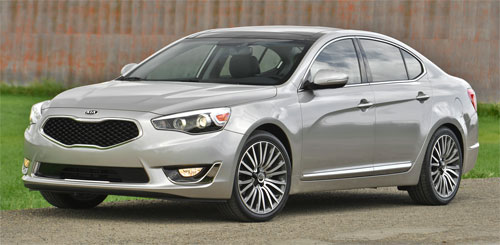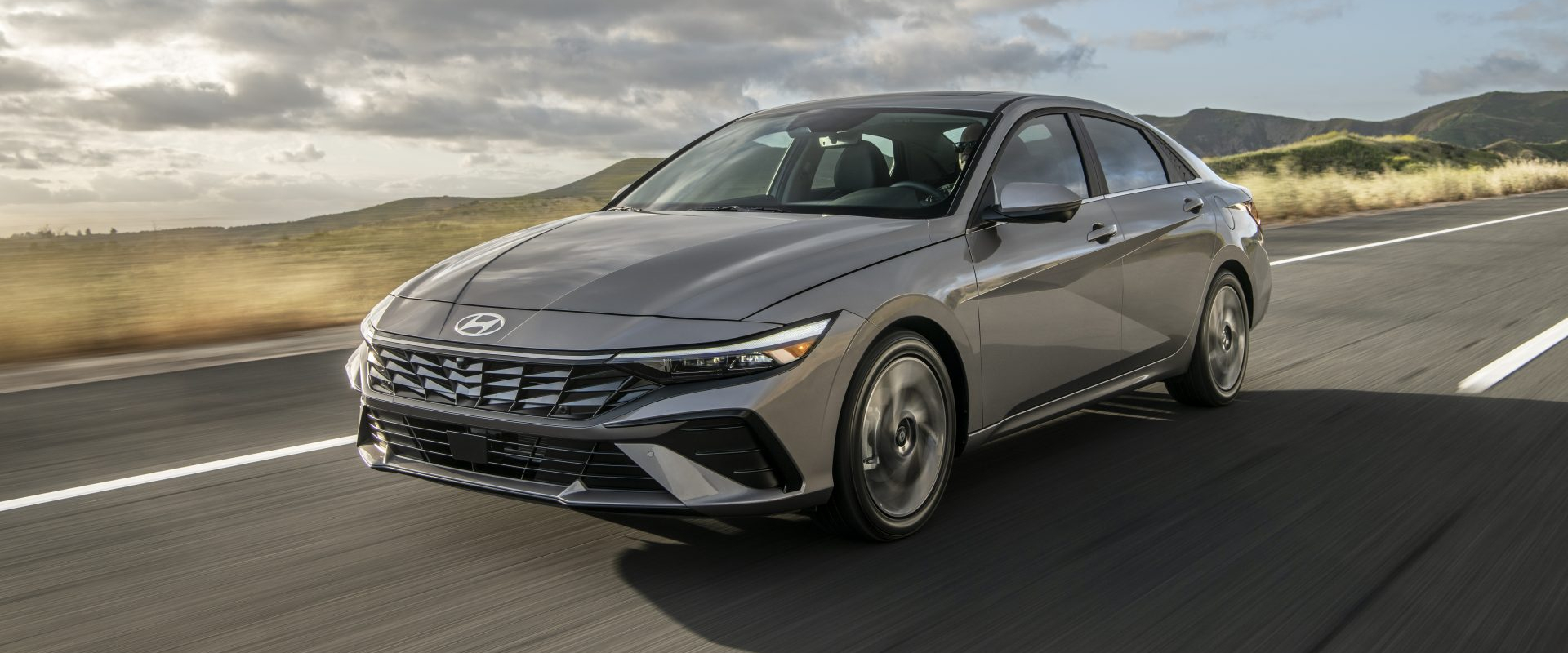2014 Kia Cadenza
Korean sister brands Hyundai and Kia have certainly made their mark on American buyers. Hyundai is now a major player in family cars and utilities, while Kia is approaching premium brand status. In that vain, Kia is now taking a shot at the U.S. full-size sedan segment, one dominated by the Detroit three and Toyota. Kia’s big four-door is called Cadenza. With a solid track record in large cars back home, let’s see if a big Kia plays well here.
While full-size cars are no longer a huge market in the U.S., it is a car class that’s speaks volumes about a brand’s status and aspirations. Witness the boost Chevrolet’s pride is receiving from their redesigned Impala. A well-priced volume brand flagship sedan can also snare a few luxury buyers as well. And, that is the mission of the 2014 Kia Cadenza.
The Cadenza might actually have a broader audience than expected since it is somewhat smallish compared to other large sedans. With a wheelbase of 112 inches, and a length of 195.5, it’s almost six inches shorter overall than Impala, but nearly five inches longer than the mid-size Kia Optima, with which the Cadenza shares more than a passing Euro-themed resemblance.
The styling is very modern, yet not trendy, and should hold up well for the long period of time that big sedans generally go between redesigns. As to the name? For those of you who avoided music lessons in school, a cadenza is the portion of a song where a soloist gets to really show their stuff, and Kia hopes their Cadenza will bring down the house.
 The upscale European influence of the Cadenza’s styling carries over to the interior. It’s driver centric, with nearly flush switchgear, yet clearly luxury oriented. Kia really sweated the small stuff too. Sensible gauges are well shrouded from glare. There are triple-sealed doors and lots of noise insulation to keep things ultra quiet; accompanied by some pleasant looking fake wood trim and soft touch materials.
The upscale European influence of the Cadenza’s styling carries over to the interior. It’s driver centric, with nearly flush switchgear, yet clearly luxury oriented. Kia really sweated the small stuff too. Sensible gauges are well shrouded from glare. There are triple-sealed doors and lots of noise insulation to keep things ultra quiet; accompanied by some pleasant looking fake wood trim and soft touch materials.
A very long list of standards includes auto fold outside mirrors, heated leather seats, navigation with SiriusXM traffic, backup warning with camera, a 550-watt 12-speaker surround sound audio system, and Kia’s UVO eServices telematics which is top notch in ease of use.
Beyond that the Luxury Package adds driver’s seat memory and ventilation as well as panoramic sunroof. While the Technology package adds a raft of safety features including Advanced Smart Cruise Control, Blind Spot Detection, and Lane Departure Warning.
While its “not quite full size” size keeps rear seat legroom far from class best, space is still generous. The seat backs don’t fold however. Still, 15.9 cu-ft of trunk space is quite reasonable.
 The Cadenza shares many mechanicals with the Hyundai Azera and that includes the 3.3-liter V6 with a front-wheel drive 6-speed automatic. It’s the brand’s most powerful V6 to date with 293-horsepower and 255 lb-ft. of torque.
The Cadenza shares many mechanicals with the Hyundai Azera and that includes the 3.3-liter V6 with a front-wheel drive 6-speed automatic. It’s the brand’s most powerful V6 to date with 293-horsepower and 255 lb-ft. of torque.
And much like the Azera, the Cadenza doesn’t launch particularly hard off the line, and power builds gently once you do get rolling. It took 7.0-seconds to reach 60, and 15.5 to see the end of the quarter mile at 94 miles-per-hour. Even using the steering wheel paddles, shifts are not especially quick, but they are premium car smooth.
Through the cones, the Cadenza feels fairly light on its feet, but not so light that you forget how big it really is. There’s plenty of luxury class weight transfer and a soft feel when you ask for rapid response. Unlike other Kias that feel sportier than their Hyundai counterparts, we can’t feel a meaningful difference between Cadenza and Azera, and neither belongs anywhere near a race track. They do belong on the highway where ride quality is downright “plush”. The front struts and rear multi-links are definitely tuned for long distance comfort.
 Government Fuel Economy Ratings are about average for its class at 19–City, 28-Highway, and 22–Combined. We saw a better than expected 25.9 miles-per-gallon of Regular in mixed driving. The Energy Impact Score is average at 15.0-barrels of annual oil use with CO2 emissions coming in at 6.7-tons.
Government Fuel Economy Ratings are about average for its class at 19–City, 28-Highway, and 22–Combined. We saw a better than expected 25.9 miles-per-gallon of Regular in mixed driving. The Energy Impact Score is average at 15.0-barrels of annual oil use with CO2 emissions coming in at 6.7-tons.
There is just one Cadenza trim level; Premium; starting at $35,900. Adding both the Luxury and Technology packages raises that to 41,900. Any way you slice it the Cadenza is a lot of large car for the money.
Indeed, taken as a whole, the 2014 Kia Cadenza does have a premium sedan nature, and yes, posture worthy of a brand flagship, but without going overboard on price. It is sportingly handsome, with a very well done interior, with lots of features, and a great ride. All things that should have Kia dealers, and Cadenza buyers, singing a happy tune.
Specifications
- Engine: 3.3-liter V6
- Horsepower: 293
- Torque: 255 lb-ft.
- 0-60 mph: 7.0 seconds
- 1/4 mile: 15.5 seconds @ 94 mph
- EPA: 19 mpg city/ 28 mpg highway
- Energy Impact: 15.0 barrels of oil/yr
- CO2 Emissions: 6.7 tons/yr
2024 Hyundai Elantra
Basic Transportation At Its Best…And That Is A Compliment
For those of you who write in every week bemoaning the fact that all we seem to do around here is test incredibly expensive cars and EVs that only the very well to do can afford, this one’s for you. It’s a commuter and budget friendly mainstay from Hyundai, the compact Elantra sedan. And, it has been nicely updated for 2024.
We clearly do enjoy driving high-performance machines and ultra-luxury rides around here, but like most of you, when it comes time to drive home at the end of a long workday, we do so in something much more practical and affordable, like this 2024 Hyundai Elantra sedan.
If you’re thinking the front end has gotten more aggressive, you’re right. Hyundai calls it a “Shark Nose” theme, and we’re guessing they were thinking more Great White than Hammerhead, though Megamouth shark would also apply. It helps for a low and wide look; more substantial than the typical compact. Other additions for ’24 include slimmer daytime running lights, revised stainless steel Hyundai emblem, reshaped front fenders, sport sedan-style rear diffuser with silver trim; a parametric pattern added to the C-Pillar, and new LED taillights that take up a lot more space on the highly sculpted decklid. Plus, new wheel designs in sizes ranging from 15- to 18-inches.
Standard engine in SE, SEL, and Limited grades is this naturally aspirated 2.0-liter I4 with 147 horsepower and 132 lb-ft of torque. Even with no hybrid assistance, it gets substantial Government Fuel Economy Ratings of 31 City, 40 Highway, and 34 Combined; we averaged a great 38.6 mpg of Regular.
Those high fuel economy numbers mean acceleration times are pretty high as well. It was in no particular hurry to get off the line at our test track, as after a slight jolt of power, it felt pretty sluggish going down the track, taking us a lengthy 9.4 seconds to hit 60 mph. Hyundai’s Intelligent Variable Transmission has some realistic simulated gear shifts built in, and they not only provided the feel of a true automatic, but kept engine noise from becoming overbearing. And while this 2.0-liter may not be a house-on-fire off the line, it has no problem keeping up with traffic, and feels like just the perfect amount of power for a practical and safe commuter car.
There are other engine options too. Two choices if you want to go faster, a 1.6-liter turbo with 201 horsepower in the Elantra N Line, and a 276-horsepower turbocharged 2.0-liter for the Elantra N; plus, one with even better fuel economy, a 1.6-liter hybrid with a 139 horsepower total output.
And despite some significant understeer, there was good feel through the cones of our handling course, both in steering and chassis feedback. We wouldn’t quite call it “point and shoot,” but it responded to inputs fairly quickly, with only moderate body roll. All-in-all, when it comes to performance, it doesn’t claim to bring a whole lot to the table, but does clearly overachieve with what it does bring.
And Hyundai is always overachieving when it comes to packing in features, yet has found a way of keeping things refreshingly simple with a good mix of touchscreen and manual controls. Lots of space too, both up front in the surprisingly wide front buckets, and in the rear bench with ample room for three. Updates for all Elantra interiors include softer materials on the door panels, upgraded instrumentation and additional charging ports, plus a surround view monitor and new H-Tex simulated leather for Limited trim.
Elantra pricing starts with an SE at $22,775, the SEL comes in at $24,725, Limited begins at $28,215, and the sporty N Line starts at $29,615. If you’re interested in the hybrid, base Blue starts at $27,400 with Limited at $30,600.
Some might say there’s not a whole lot that’s earth shaking about the 2024 Hyundai Elantra, but that’s mostly why we like it so much. When it comes to just delivering good, basic transportation with a high dose of unexpected amenities, Hyundai delivers once again.
Specifications
- Engine: 2.0-liter I4
- Horsepower: 147
- 0-60 mph: 9.4 seconds
- 60-0 Braking: 111 ft (avg)
- MW Fuel Economy: 38.6 MPG (Regular)
- Transmission: IVT
- Torque: 132 lb-ft
- 1/4 Mile: N/A (Track Maintenance)
- EPA: 31 City / 40 Highway / 34 Combined







